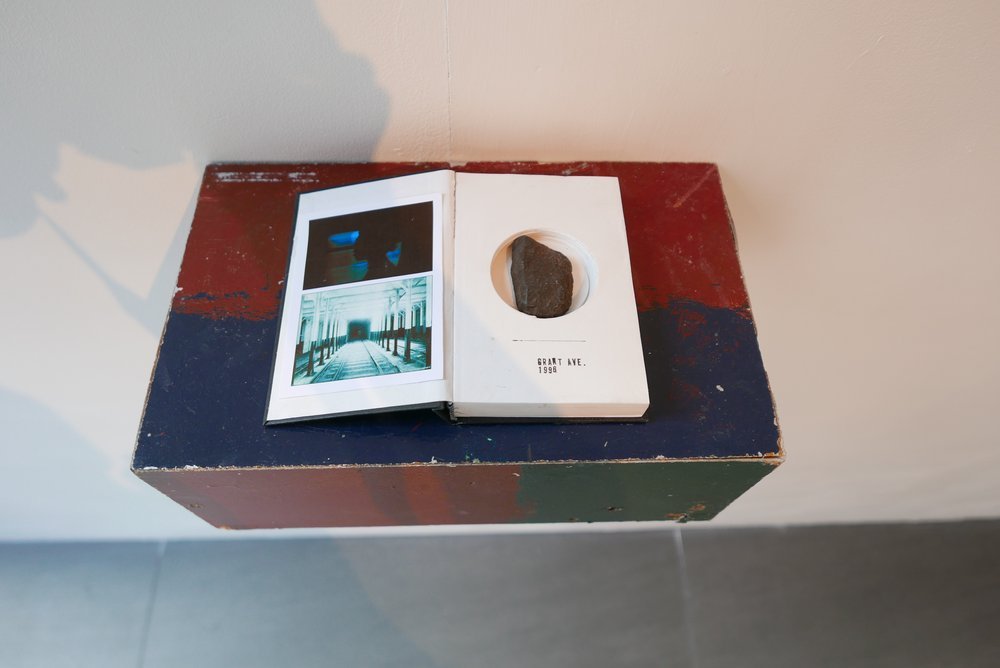Public Secrets 2022. Sculpture from found wooden hoardings. Wall mounted photograph.
Indelible Odyssey 2022. Found Woden hoardings, light boxes, acetates.
Grant Avenue 1996. Sketch book, Photographs, New York subway ballast stone. Shelf from found wooden hoardings
Bad Gateway 2022. Floor tiles and sculpture from found hoardings
Chorus 2022 Acrylic, toner transfer, UV matt varnish on canvas 200x150
Gully 2022 Acrylic, toner transfer, UV matt varnish on canvas 200x150
Raid 2022 Acetate in intermittent light, wall piece
Raid 2022 Canon Ixus, Olympus Mu cameras set in concrete 44x34cm
Friendly enemies 2022, oil and paper collage on canvas 150x120cm
Section 2019. Oil, toner transfer, spray paint, acrylic on canvas 200x150cm
15” Money Speedmaster alloy wheels
Bridge Hugger 2022. Found concrete, spray paint, steel
Territorial Gestures OHSH projects London Sept 2022
The first time I asked Mike Ballard how he made his paintings he was reluctant to divulge the entire process, saying that there should be a bit of mystery to creativity - or words to that effect. I believe his reluctance stemmed from a career that, in its formative years and largely throughout, has been somewhat enigmatic. Ballard has always been slightly muddy on the details of where he sources his materials, how he creates his art or whether or not the activity is completely legal. It is this unknowing that makes his work all the more alluring.
Ballard creates at a fast pace and with regimented accuracy. The hoardings used in his sculptures have often been obtained through precise operations to appropriate well worn and weathered hoardings only to replace them, on unsuspecting building sites, with crisp, sparkling new ones. It is the marks found on these used hoardings that inform Ballard’s paintings as well as an extensive inventory of urban symbolism that can be seen throughout his work. He tells me: “I feel there’s a dynamic tension between the found (hoarding surface), and the recreated paintings, both taken from real life. They carry the cargo of memory in their surfaces, ghosts, haunting the city, presented as rugged structures and meticulously constructed formal paintings.”
Ballard’s practice could be described as ‘architectural hauntology’. He collects and catalogues spectral marks and symbols that have been created from a city in a constant state of flux and development, and transfers them on to wood, canvas and concrete. He uses photographic memories of his journey that are laboriously hand rubbed onto surfaces manifesting an archive of his personal journey as a creator - a personal history of discovering his identity within his immediate environment, and peer group. The paintings also deal with the politics of surface and ownership, authorship, creation by removal. “I see and feel the most beautiful abstract micro gestures in the scratches and rips of a sticker being worn or peeled away from the surface. These tiny marks are then magnified and transposed onto the surface of the canvas, and lay bare a never ending battle for surface, space and ownership within the metropolis,” Ballard explains. This ghostly symbolism, of a time that has passed, conjures something very current and puts it into a dramatically different context.
At the same time this body of work - which incorporates elements that might not not be as familiar to followers of Ballard’s work, such as smaller concrete and metal sculptures like ‘Bridge Hugger’ - is the most accomplished and extensive that he has exhibited to date. The narrative running throughout the exhibition has its genesis in the metal and concrete of the Aston train tunnel, where Ballard spent a lot of time in his youth, fascinated with the non-space that he describes as “hidden or overlooked worlds”. The new work also acts as a refreshingly personal insight into his journey as an artist and human being. The openness displayed throughout the exhibition is a different direction for Ballard - a new desire for the audience to learn his process, and how it came to be.
Eric Thorp











